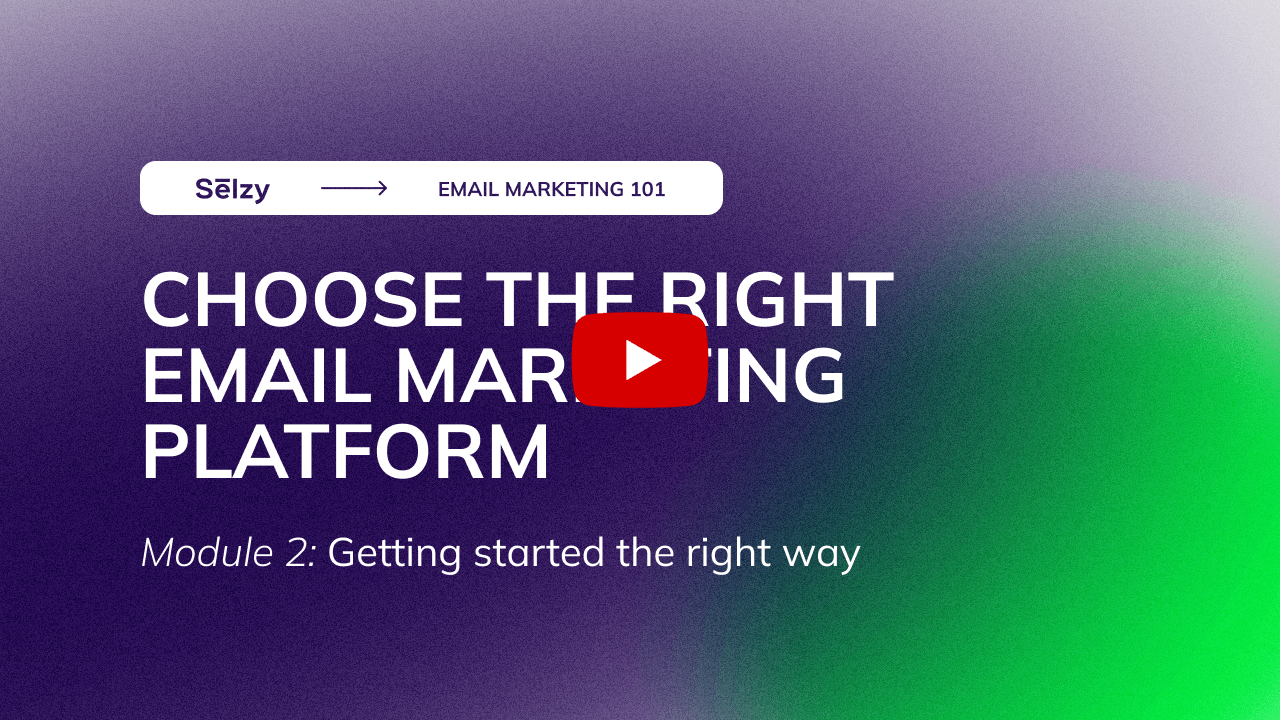How To Choose Email Marketing Platform
This is a transcript of lesson 3 of Email Marketing 101 Course by Selzy.

Hello! Welcome to lesson 2 of module 2, where we learn how to prepare for bulk sending. In this video, we’ll discuss how to choose an email marketing platform for your business.
There are many platforms on the market: like MailChimp, Sendinblue, GetResponse, Selzy. How do you know which one to choose? Let’s find out.
If you ever tried to choose an email marketing platform, you probably know that they all have the same basic features at their core:
Email builder + templates
Analytics
Sign-up forms
Automation
Segmentation
List management
So, how are you supposed to make a choice if it all looks more or less the same?
To choose a platform that will work best for you, you need to look at the features that differ from platform to platform. The four most important things are:
Pricing
Ease of Use
Advanced features, and
Customer support
Let’s look at each of them in more detail.
Aspect #1: Pricing
An email marketing platform can cost anywhere from a couple to several hundreds dollars per month, so anyone can find a pricing plan that suits them best.
However, when making a choice, think about your needs first. Just going with the cheapest option may seem like a plan, but it can trick you later. For example, if you find out that you lack the features you need.
So, think about what you need from your email marketing software and make sure that the solution you’re looking at has them. For example, think whether you need unlimited emails or you’re fine with a cap for a better price.
If you’re still not sure, here are two things to consider:
One thing is the pay-as-you-go feature. Not all platforms have it, but it can work great for businesses that send irregularly, like a couple of times a year. It means that instead of a flat month fee, you’ll pay for each email you send. With Selzy, for example, you’ll be paying half a cent per email.

This visual is only available in a video lesson
The second thing is the limitations of the free plan. Most platforms offer a free plan with a limit on available features, as well as the number of contacts and emails.
For example, Mailchimp allows you to send 1,000 emails to 500 people on a free plan. Selzy allows 15,000 emails to 1,000 people. ActiveCampaign allows only 100 emails to 100 people.
Check that the free plan is big enough for you to test out all the features of the platform.

This visual is only available in a video lesson
However, don’t try to find a free plan to substitute a paid option. We really don’t recommend using free plans for doing business.
Why? First up, many platforms include their branding into emails sent with a free plan.

This visual is only available in a video lesson
But most importantly, if you’re gonna put time and effort into your email marketing, your contact list will sooner or later grow beyond the free plan cap. It makes more sense to enjoy all the perks of a paid plan right now, from the beginning.
Aspect #2: Ease of use
This one really depends on your personal preferences, so we cannot guide you here.
Just sign up with a few platforms and see how they make you feel — that’s what the free plan is for. If some UX feels particularly frustrating to use, maybe it’s not worth it.
Or imagine this: a new person joins your team and you have to teach them to use the platform. How long will it take?
An email marketing platform is the tool you’ll be doing all your email marketing work in, so it better feel intuitive.
Aspect #3: Advanced features
These may include advanced automation and analytics, text messages, or integrations with other services.
For example, there’s an “abandoned cart” feature, when an online store emails you a link to products that you added to your cart but did not buy. Not all email marketing platforms have this feature.

This visual is only available in a video lesson
Or a Shopify integration.

This visual is only available in a video lesson
So, how do you make a choice?
Your first instinct might be to go for the platform with the most features and most integrations — just in case you need them in the future.
The downside is that this way, you’ll probably end up with the most expensive software. And will be paying for the features you won’t ever use.
So our advice here would be to look for integrations you already use and for the features you’ll use from the start. If you already use Xcart, look for the platform that’s integrated with it. But if you don’t use any, say, CMS at the moment and are not planning on adding it in the near future, don’t worry about it.
For a detailed comparison of features of the most popular email marketing platforms, check out the Recommended Reading section under this lesson.
Aspect #4: Customer support
And the last — but not least — thing you should consider when choosing a platform is how their user support works.
The platform is a proxy between you and your customers, so it’s important that you trust it and can rely on it in difficult times, like if the emails were not delivered or went to spam.
Platforms may offer support via different channels: for example, only via chat or over the phone as well. Think what works best for you.
Working times also vary a lot. For example, at ActiveCampaign live support is available only during weekdays for a limited time.

This visual is only available in a video lesson
Now, imagine this: it’s 1 am in the morning and you’ve just noticed that like 30% of your email campaign went to spam. Now that’s when you need a helping hand of your platform’s support team to figure things out! If this is your case, then 24/7 support is what you are looking for.
Selzy’s support team is here to help 24/7, via chat, email or phone. Even on the free plan!

This visual is only available in a video lesson
Another important point is the languages that a support team speaks. If English isn’t the preferred language of communication for you or someone on your team, check the platform’s support languages. Some of the services provide support in Portuguese, French, Spanish, etc. Though Mailchimp seems like a popular option in many aspects, they only provide customer support in English.
The average response time is important too. You can check it by just opening a live chat on any platform’s website. For example, Selzy’s average response time is under 2 minutes.
Conclusion
So, let’s wrap it up.
All email marketing platforms have the same basic features. To make a choice, compare pricing, advanced features, integrations, ease of use and the quality of user support and try the platform you like via the free plan. However, don’t use the free plan for doing business: it will get restrictive too soon.
If you need more details on different platforms, we’ll link you to a comprehensive guide under this video.
Once you’ve chosen your platform, go to Lesson 3 to get ready for sending!
This is a transcript of lesson 3 of Email Marketing 101 Course by Selzy.